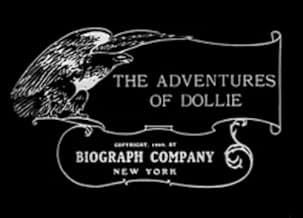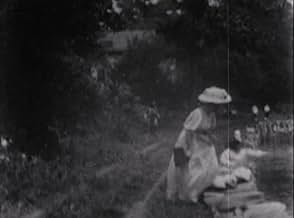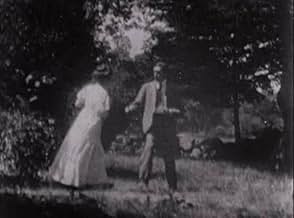अपनी भाषा में प्लॉट जोड़ेंOn a warm and sunny summer's day, a mother and father take their young daughter Dollie on a riverside outing. A gypsy basket peddler happens along, and is angered when the mother refuses to ... सभी पढ़ेंOn a warm and sunny summer's day, a mother and father take their young daughter Dollie on a riverside outing. A gypsy basket peddler happens along, and is angered when the mother refuses to buy his wares. He attacks mother and daughter but is driven off by the father. Later the g... सभी पढ़ेंOn a warm and sunny summer's day, a mother and father take their young daughter Dollie on a riverside outing. A gypsy basket peddler happens along, and is angered when the mother refuses to buy his wares. He attacks mother and daughter but is driven off by the father. Later the gypsy sneaks back and kidnaps the girl. A rescue party is organized but the gypsy conceals ... सभी पढ़ें
- निर्देशक
- लेखक
- स्टार
फ़ीचर्ड समीक्षाएं
*** 1/2 (out of 4)
The first (of 400+) film directed D.W. Griffith is about a pair of gypsies who kidnap a three-year-old girl. When the girl's parents come looking for her the gypsies hide her in a barrel, which they accidentally drop in the river. Griffith's skill is certainly in full display here as his use of editing is right on the mark as he builds suspense of the girl going down the river. A wicked sense of humor is also on display here.
Those Awful Hats (1909)
*** (out of 4)
D.W. Griffith comedy about a movie crowd getting angry because the women's large hats are blocking the screen. This is shorter than most of the shorts from this period but it's a very funny little gem.
This is where the Legacy of The Father Of The Cinema Begun. A quintessential human drama of historical importance. D W Griffith, the father of cinema, who established so many dramatic genres and sub-genres in Cinema World begin his unbeatable career with this short. In the same year he shot 48 shorts for a studio but for historical notes, The Adventures of Dollie stands as a highly important film. The film tells the story of a young girl who, after being kidnapped by a gypsy peddler, ends up trapped in a barrel as it floats downriver toward a waterfall. Within 13 minutes, Griffiths closes on deal with so many substances such as family, emotions, gypsy, thrill and happy ending. That scene when the gypsy tries to rob the woman, he does, the woman fights back, the small girl also throws her hand at him and the husband comes from behind and beats the bad guy. This all happens within 15 Seconds, yes that's the thing to notice. Its not the end but even the later part builds a strong story of commonalty, which, certainly wasn't common for 1908. Griffith's editing also packs a great punch while telling this quintessential storyline in thrilling manners. Well, 1908 wasn't the time where one would have given solid acting performance as the motion pictures were just started learning to take a breath so let's not talk about that and to be frank i couldn't even recognise their faces as there were no close-up shots. It is hard to rate the films made before 'Birth Of A Nation' (1915) because everything was at learning stage then. So, don't take the rating much seriously as i just had to rate it something, somehow. It's a primary schooling for us Movie Buffs where acknowledging and understanding cinema matters more than the Grades.
RATING - 7/10*
By - #samthebestest.
Early Works of Film Directors-Review # 8: D. W. Griffith and G. W. Bitzer's The Adventures of Dollie
However, Griffith appears to acknowledge one difference between cinema and theatre, one that was to become key to his style ever after, and that is the use of depth. Virtually all the movement in The Adventures of Dollie is towards or away from the camera, as oppose to across it. The long static takes particularly highlight this approach. This is before editing within a scene or using inserts were common methods, and this means we get some odd-looking (and very theatrical) set-ups, as in the scene where Dollie is kidnapped, the father walks away and the gypsy approaches all within the same shot, meaning our sense of logic tells us that the father can't be more than a dozen paces away when his girl is snatched. Griffith is still using the concept of stage wings for entrances and exits, imagining that once someone has walked out of sight they are out of the scene, which looks unnatural for cinema. However, rather than having them at left and right as on a stage, the father exits walking straight into the foreground, while the gypsy emerges from the bushes in the background. It still looks illogical, but it shows a willingness to work on solutions towards a non-theatrical style.
In doing this, Griffith is showing nothing entirely new and certainly nothing exceptional, but he is showing a certain tendency, a particular way of thinking about the medium that would later lead to amazing things. And Griffith also displays his quality as an ideas man that transcends all technique and experience. For example, when the father searches through the gypsy caravan, the gypsy is resting his foot on the barrel in which Dollie is hidden, cockily flaunting the secret before his enemy. It's little touches like this, giving a scene that little bit of character, that separate the great directors from the merely good ones.
"The Adventures of Dollie" is about a little girl who is kidnapped by gypsies and ends up going on a crazy ride in a barrel. There's really little else to it than that, although there is some nice cinematography involved and the story works for what it is. That being said, the film is really only worth seeing for historical reasons as it doesn't contain the excitement and buildup of his later material, and it would take until 1912 or so before Griffith would begin shooting more advanced, better crafted shorts.
क्या आपको पता है
- ट्रिवियाDirectorial debut of D.W. Griffith.
- कनेक्शनEdited into Spisok korabley (2008)
टॉप पसंद
विवरण
बॉक्स ऑफ़िस
- बजट
- $1,000(अनुमानित)
- चलने की अवधि12 मिनट
- रंग
- ध्वनि मिश्रण
- पक्ष अनुपात
- 1.33 : 1
इस पेज में योगदान दें




















